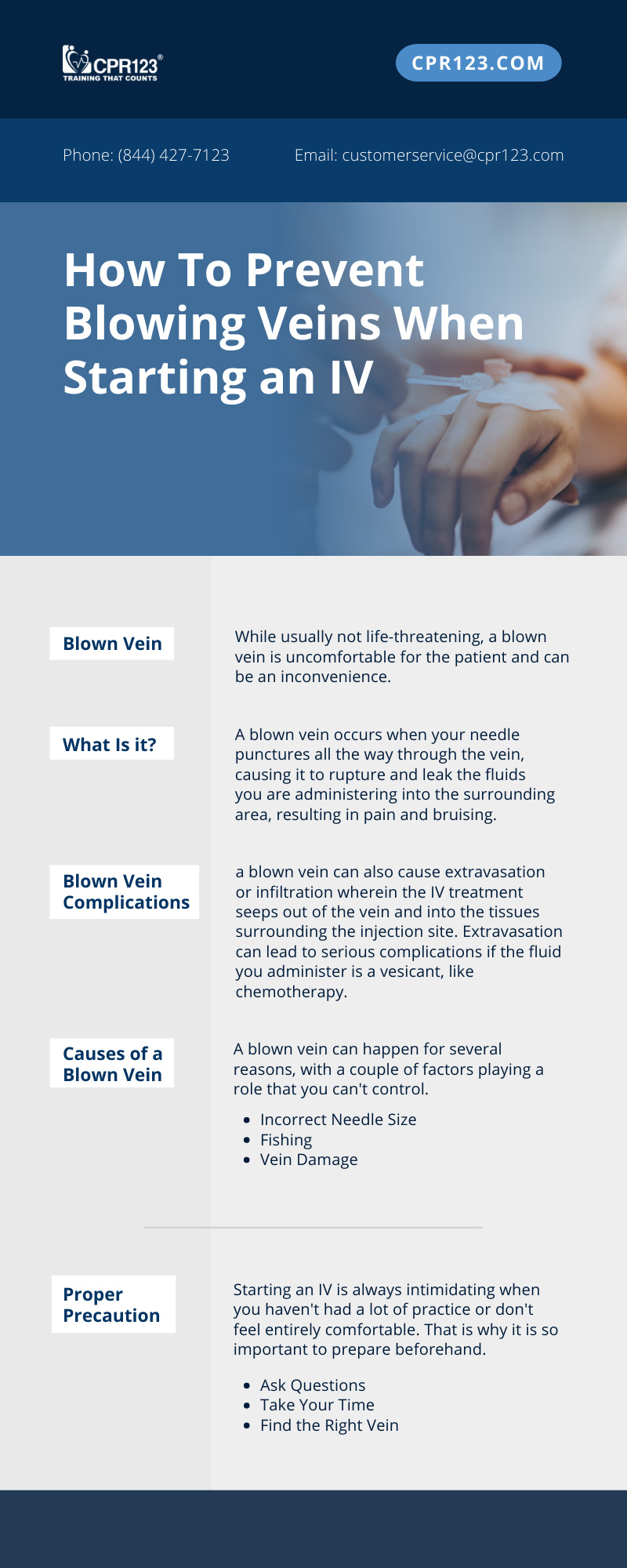IV insertion is the cornerstone of healthcare, and no matter what you do in the field, you will have to insert an IV at some point in your career. With the process being so common, it is crucial that you know how to insert an IV correctly. That is especially so if you are a nurse, as a large aspect of your role will require administering fluids and medications via IV therapy.
Blown Vein
You have likely had an IV started on you before. Hopefully, the process was quick, nearly painless, and it was over as soon as it started. However, if that experience does not sound exactly familiar, you might have experienced a blown vein. While usually not life-threatening, a blown vein is uncomfortable for the patient and can be an inconvenience. As such, you want to ensure you feel confident starting an IV, as it will decrease the likelihood of you blowing a vein on your patient.
What Is it?
A blown vein occurs when your needle punctures all the way through the vein, causing it to rupture and leak the fluids you are administering into the surrounding area, resulting in pain and bruising. If you blow a vein, you will usually notice swelling and increased discoloration around the injection site. Moreover, your patient will usually let you know they are in pain and may describe a stinging or painful sensation.
Once this occurs, you must immediately remove your catheter and try another vein, as you can no longer use that vein until it completely heals. Many nurses will say that the most difficult challenge to a blown vein is knowing whether you have actually blown it or not. As such, it is essential that you stay alert to the signs and symptoms of a blown vein when administering IV therapy. You must also learn how to properly insert an IV, as it decreases the chances of one occurring in the first place, keeping you from the complications that may arise.
Blown Vein Complications
The healing process from a blown vein can take nearly two weeks, usually heals without complication and is not an issue for routine check-ups. However, it can complicate treatment if the patient has a long-term illness that requires periodic IV therapy. The reason for this is that sometimes a blown vein can cause the walls of the vein to swell, which can block the patient from receiving IV medication throughout the body.
Moreover, a blown vein can also cause extravasation or infiltration wherein the IV treatment seeps out of the vein and into the tissues surrounding the injection site. Extravasation can lead to serious complications if the fluid you administer is a vesicant, like chemotherapy. A vesicant is an irritant, and if it leaks due to a blown vein, it can cause necrosis, blisters, and even limb loss.
Prepare Yourself
As you grow more comfortable in your profession as a nurse, doctor, or any other type of healthcare provider, you will find that IV insertion comes as second nature to you. However, when you first begin, you might feel wooden during insertion since the process is still quite new. As such, this unfamiliarity might increase the likelihood of a blown vein. But with the proper training, you will feel secure in no time!
Are you looking for an IV certification class that will give you the security and confidence you need when administering an IV? We have designed our course to equip you with as much knowledge as possible to help prevent a blown vein when starting an IV. CPR123 has knowledgeable trainers ready to help you learn all about IV insertion, IV therapy, maintaining and discontinuing an IV, and much more.
Causes of a Blown Vein
IV insertion will take a huge chunk of your time if you are a nurse. It stands to reason that you want to do everything possible to avoid a blown vein from happening in the first place. A blown vein can happen for several reasons, with a couple of factors playing a role that you can’t control.
Incorrect Needle Size
Most healthcare providers will use a 21-gauge needle for routine blood draws, as it is small enough to prevent discomfort to the patient. A needle that is too large will be uncomfortable for the patient and make it more likely for you to puncture through the vein.
Fishing
When you start a vein, the best thing you can do to avoid blowing it is not to go fishing—no, not the kind of fishing involving a lake. Fishing happens when you insert a needle, but it does not enter the vein on the first try, so you move the needle around, “fishing” for another. To avoid this, ensure you hit a vein accurately by inserting the needle at the proper angle, around 15-25 degrees.
Vein Damage
Veins can blow for any reason, even when you take every precaution possible. A blown vein can be due to prolonged IV drug use, damaging one’s veins permanently. Long-term IV use can be due to treatments like chemotherapy or drug abuse that can damage the vein and cause scar tissue to form permanently.
Proper Precaution
Now that we have gone over some of the things that can cause a vein to blow, we will go over some precautions you can take before starting your IV. Starting an IV is always intimidating when you haven’t had a lot of practice or don’t feel entirely comfortable. That is why it is so important to prepare beforehand.
Ask Questions
As a healthcare provider, you constantly feel like you never have enough time to spend with each of your patients. If you are new to IV insertion and still finding your way, it is always a good idea to take some extra time and ask your patient questions. Asking them questions will help keep you from making any mistakes and could prevent a blown vein. Good communication is the foundation of good healthcare, so ask your patients if they are prone to blown veins or have had IV drug treatments in the past.
Take Your Time
In addition to asking questions, make sure to take your time with each insertion, especially if you are new to the field, as there is quite the learning curve. Observe the patient and the various factors that could increase the likelihood of a blown vein like the patient’s age, medical history, etc. Moreover, stabilize the patient to ensure they don’t move before observing their veins to find the right one.
Find the Right Vein
One of the best ways to prevent a blown vein is to choose the right one. Finding the right vein will differ with each patient, a common area where healthcare providers start IVs is in the A.C. region —the inner area of the fold of your arm. This area is however not recommended; the recommended area is the veins in the forearm where there is no flexion.
Usually, finding a vein will prove more difficult on female patients as they tend to have more subcutaneous fat, unlike males. If you are sticking a rolling vein, have your patient stiffen the insertion region and tighten the skin in the area; this will give you more control and access.








